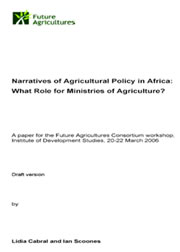{jathumbnail off} Much policy research on African agriculture has focused more on ‘what policy’ type of questions,rather than on the processes by which policy is made and implemented (Omamo, 2004). The focus has been on ‘policy fixes’, based often on idealised models of the ways things should be, rather than the way they are, or are likely to be.
Much policy research on African agriculture has focused more on ‘what policy’ type of questions,rather than on the processes by which policy is made and implemented (Omamo, 2004). The focus has been on ‘policy fixes’, based often on idealised models of the ways things should be, rather than the way they are, or are likely to be.
Researchers, consultants, donor agencies and decision-makersat government offices therefore concentrate on devising solutions for problems and overlook the complexities of the process of translating such elaborate, technical policy prescriptions into practice. Much of this translation role is left to ministries of agriculture. But what role should they play giventhe policy debates raging about the future of agriculture in Africa?
This paper provides a preliminary contribution to the debate on agricultural policy processes by focusing on the current roles and capacity of ministries of agriculture in devising and delivering agricultural policies. By unpacking the different ‘narratives’ – or storylines – about agricultural policies being pushed by different actors in the policy process, the paper asks what kind of ministry of agriculture is envisaged, either implicitly or explicitly? Three different versions are elaborated.
One sees the return of the hey-day of the sectoral ministry with capacity and policy clout – to address the major constraints of agriculture, it is argued, what is required is a strong, well-funded line ministry, and the challenge today is to rebuild such an organisation. A second – at the other extreme – sees such sector all ministries taking on a minimal role, focused on oversight and regulation, as the private sector takes on a more substantive role in a ‘free-market’ environment.
A third, perhaps less stridently articulated than the other narratives, sees an important role for the state – and the ministry of agriculture,together with other state agencies – in addressing the coordination and intermediation roles of getting markets to work effectively, while ensuring at the same time public efforts are targeted to poverty reduction. Which of these models – or hybrids and variants of them – make sense today? The analysis in this paper is conducted around two hypotheses.
The first is that, in the twenty-first century, ministries ofagriculture are no longer the key architect and driver of agricultural policies and policy reform. Other public sector agencies and non-state actors play, increasingly, a more central role in the reform and development of the agriculture sector. Indeed, over the years, the position of the state inthe agriculture sector seems to have been continuously eroded by a series of interconnected factors,which include inter alia:
(i) the demise of the socialist model of state intervention;
(ii) thewidespread adoption of the orthodox liberalization/privatisation approach to economic growth;
(iii) the structural transformation of the global economy (both at political, economic, social and culturallevels) driven to a large extent by the dramatic fall in transportation and communication costs;
(iv)the pervasive discourse on government failure, particularly in Africa; and
(v) the expansion of thethird (non-governmental and not-for-profit) sector beyond emergency relief, responding to both stateand market failures, and now emerging as an important actor in the development process.
These have contributed to the reshaping of agricultural governance structures, as well as of functions and structures of ministries of agriculture – including withdrawal from direct involvement production and marketing activities, privatization of public-sector enterprises, allegedly greater emphasis of the public sector on regulatory and enabling functions and provision of classic public goods (rural infrastructures and research) and development of new partnerships and outsourcing arrangements with the private and NGO sectors. Concomitantly, and to some extent in consistency with the above,there has been, over the last two decades, a persistent reduction in the amount of financial resources(domestic and external) allocated to the agriculture sector and to ministries of agriculture inparticular.
